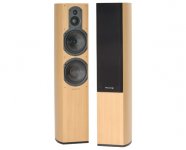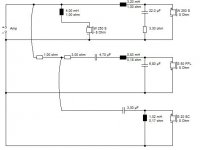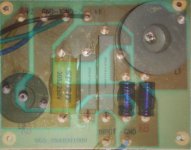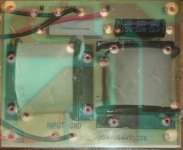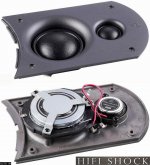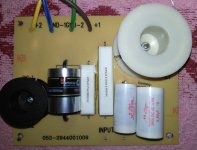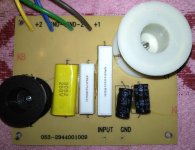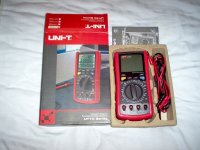Hello !
I got, a few days ago, a pair of Wharfedale Diamonds 9.6, a 3,5 ways with 4 speakers : a dome tweeter, a dome medium, a medium-bass speaker, and a... boomer-woofer (?).

From what I could read online about the crossovers, there's first and old thread on diyaudio :
Modifying Diamond 9.6 crossovers.
It seems that the crossovers frequencies are :
150 Hz, 1 khz, and 6 khz.
On this thread, system7 draw the crossover schematic, here it is :

Derwhalfisch, who begun this thread, created a nice infographic for the crossover boards :


And now, the problem :
I find the trebles on these speakers... Difficult to find ! 😕
The tweeters are working, it is not the problem.
But it sounds like with a curtain covering the tweeters... The cymbals sounds as if there was felt glued on it, the triangle like recorded from the backstage. There is not this high treebles giving "brillance" to the percussions, or a hint of acidity to the violins... And the medium is powerfull. So, on a small jazz formation, or with electronic music, you can forget these defaults for a time. But on a symphonic orchestra, no high on the violins, and a medium making all the stringed instrument...Messy, not clear.

So my questions are :
- is there a owner of these speakers, or of on floor speakers of the same line, who could make the same constatation about the trebles of these Wharfedale ? Is this sound the original sound of these speakers ?
- If it's not, is it possible that the components of the crossover have suffered from an overload in their past, with all the speakers in working order ?
- And, if this is the normal tonality of these Diamonds, is it possible to improve a little the highest frequencies in changing slightly some values in the crossover, to give a little "shine", a little more relief to these trebles ? I find that this tonal balance, with emphasis on the mediums and weak trebles, is disapointing...
Thank you ! 🙂
I got, a few days ago, a pair of Wharfedale Diamonds 9.6, a 3,5 ways with 4 speakers : a dome tweeter, a dome medium, a medium-bass speaker, and a... boomer-woofer (?).
From what I could read online about the crossovers, there's first and old thread on diyaudio :
Modifying Diamond 9.6 crossovers.
It seems that the crossovers frequencies are :
150 Hz, 1 khz, and 6 khz.
On this thread, system7 draw the crossover schematic, here it is :
Derwhalfisch, who begun this thread, created a nice infographic for the crossover boards :
And now, the problem :
I find the trebles on these speakers... Difficult to find ! 😕
The tweeters are working, it is not the problem.
But it sounds like with a curtain covering the tweeters... The cymbals sounds as if there was felt glued on it, the triangle like recorded from the backstage. There is not this high treebles giving "brillance" to the percussions, or a hint of acidity to the violins... And the medium is powerfull. So, on a small jazz formation, or with electronic music, you can forget these defaults for a time. But on a symphonic orchestra, no high on the violins, and a medium making all the stringed instrument...Messy, not clear.
So my questions are :
- is there a owner of these speakers, or of on floor speakers of the same line, who could make the same constatation about the trebles of these Wharfedale ? Is this sound the original sound of these speakers ?
- If it's not, is it possible that the components of the crossover have suffered from an overload in their past, with all the speakers in working order ?
- And, if this is the normal tonality of these Diamonds, is it possible to improve a little the highest frequencies in changing slightly some values in the crossover, to give a little "shine", a little more relief to these trebles ? I find that this tonal balance, with emphasis on the mediums and weak trebles, is disapointing...

Thank you ! 🙂
Attachments
Perhaps Steve (system7) will pop up once more to give you advice.
All I can say at the moment is that loudspeakers are generally poor at reproducing the sound of a symphonic orchestra.
All I can say at the moment is that loudspeakers are generally poor at reproducing the sound of a symphonic orchestra.
I've found the harder cone materials are able to better and more precisely overlay the complex timbres and waveforms of separate instruments with sufficient separation and clarity.
Cymbals having shimmer and actually sounding like a metallic instrument. Brass having the sharp edged rasp.
you have to go really big and use multiple drivers operating well within linear excursion so they can handle the dynamics of an orchestra and use up the xmax as required on crescendos to not compress. My current 3 ways can't do this. (more SD required 🙂
Cymbals having shimmer and actually sounding like a metallic instrument. Brass having the sharp edged rasp.
you have to go really big and use multiple drivers operating well within linear excursion so they can handle the dynamics of an orchestra and use up the xmax as required on crescendos to not compress. My current 3 ways can't do this. (more SD required 🙂
If you have the same speakers than mine, you're lucky ! I don't think the same thing about my Diamonds. The 2 dome speakers should be able to, you're right, but it miss something in the very trebles, and that makes all the sound... As muffled.I've found the harder cone materials are able to better and more precisely overlay the complex timbres and waveforms of separate instruments with sufficient separation and clarity.
Cymbals having shimmer and actually sounding like a metallic instrument. Brass having the sharp edged rasp.
No, it's not about power, it'as about ... readability of the mediums, about details.you have to go really big and use multiple drivers operating well within linear excursion so they can handle the dynamics of an orchestra and use up the xmax as required on crescendos to not compress. My current 3 ways can't do this. (more SD required 🙂
No, i can't make a real one. But I have a video receiver with automatic equalization, by microphone. When I tested the equalization with these speakers, the amplifier settled +6 db in the trebles.Can you make a frequency response measurement?
But I don't know if this is a realiable measure, even on a "flat" setting.
What I can say now is that, during this post, I hear the Stravinsky's "Firebird", on a Telarc recording, a superlative recording, with a Quad 405 amp. With my old speakers (cheap B&W Vision DS2, not the most precise but well balanced), the triangle was in my room. Now, it's in my bedroom... Under the blankets ! OK, I exaggerate, but you see what I mean.
I think I will check the values of the resistors and capacitors on the crossover. Perhaps the speakers were exposed to an overload, and some values changed
If these values are OK, perhaps I will try to replace the tweeter, first with a genuine one, and after with an other, with the same size, to put in the cabinet, I don't want a Frankenspeaker.
Last edited:
Yes could be the tweeters that are half blown I tried that once. That a tweeter would still play but at much lower volume
Yes could be the tweeters that are half blown I tried that once. That a tweeter would still play but at much lower volume
Hello Guerilla !
I didn't know that a tweeter can be "half-dead" (a Schroedinger tweeter 😀 ?). I suppose that, in this case some turns in the voice coil are in contact ?
If is it THIS accurate problem, is it possible that the tweeter, with an internal resistance decreased, make more electric power going to the medium?
Possibly the tweeters are suffering from semi-dried-up ferrofluid. Difficult to prove without some degree of dismantling. But if they are, it should be entirely possible (but a bit fiddly) to renew the ferrofluid, having first removed as much of the old stuff as possible. Replacement ferrofluid seems to be quite easy to obtain.
There's quite a lot of advice regarding this on the internet (often concerning KEF's T33).
There's quite a lot of advice regarding this on the internet (often concerning KEF's T33).
That's a VERY interesting track to follow. I would not have thought of it... I will get informations !!Possibly the tweeters are suffering from semi-dried-up ferrofluid. Difficult to prove without some degree of dismantling. But if they are, it should be entirely possible (but a bit fiddly) to renew the ferrofluid, having first removed as much of the old stuff as possible. Replacement ferrofluid seems to be quite easy to obtain.
There's quite a lot of advice regarding this on the internet (often concerning KEF's T33).


There must be something wrong with these. Wharfedale are not incompetent! 😀
Dried out Ferrofluid is a good suggestion.
Sonitus Audio :: Sonitus Audio Ferro Fluid (ferrofluid) for Speakers and Compression Drivers 0.5ml PS4.99 IN STOCK (2 Nov 2018)
Most tweeters are easy to take apart and clean and replace the old dried-up stuff.
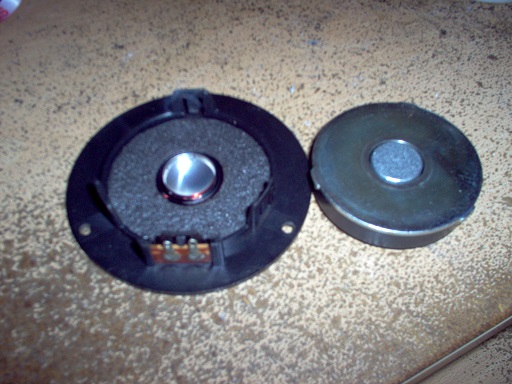
All tweeters and supertweeters of this type should have a resistance of 3-6 ohms if electrically intact.
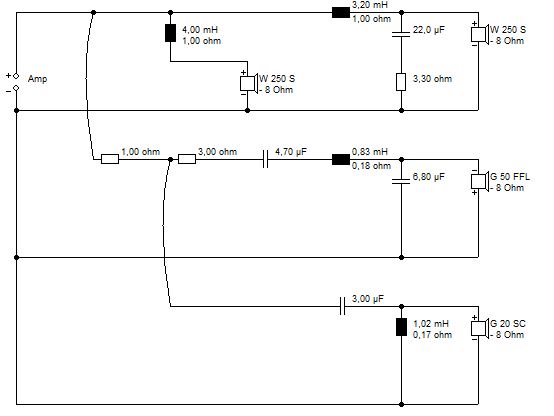
I can't remember what I was doing with this circuit, but it looks possible. 305J is 3uF polypropylene I reckon and won't blow. You can test the big dome tweeter for DC resistance in situ. The smaller dome needs unsoldering to test because the coil will short it out. A 1.5V battery should make both crackle.
I see no problem with testing for continuity on any of the components with a resistance multimeter. Possibly the 1R is a polyfuse. Can't remember.
Sweepgen is a useful audio signal generator that I use sometimes:
Audio Tools - from David Taylor, Edinburgh
Dried out Ferrofluid is a good suggestion.
Sonitus Audio :: Sonitus Audio Ferro Fluid (ferrofluid) for Speakers and Compression Drivers 0.5ml PS4.99 IN STOCK (2 Nov 2018)
Most tweeters are easy to take apart and clean and replace the old dried-up stuff.
All tweeters and supertweeters of this type should have a resistance of 3-6 ohms if electrically intact.
I can't remember what I was doing with this circuit, but it looks possible. 305J is 3uF polypropylene I reckon and won't blow. You can test the big dome tweeter for DC resistance in situ. The smaller dome needs unsoldering to test because the coil will short it out. A 1.5V battery should make both crackle.
I see no problem with testing for continuity on any of the components with a resistance multimeter. Possibly the 1R is a polyfuse. Can't remember.
Sweepgen is a useful audio signal generator that I use sometimes:
Audio Tools - from David Taylor, Edinburgh
Last edited:
I've seen about 3-4 treads on wharferdale diamonds.
All have ended up with using good tweeter caps. Even the relatively inexpensive Mundorf MKP line has a really nice effect.
Best,
E
All have ended up with using good tweeter caps. Even the relatively inexpensive Mundorf MKP line has a really nice effect.
Best,
E
Really, Erik! How can "upgrading" the capacitors to expensive boutique types fix a broken speaker if the fauit is elsewhere? 😕
Unless the capacitors are broken anyway:

We can't discount the blue NP types on the right being open circuit, and these affect the big dome, but really the troubleshooting is the place to start.
This sort of speaker gets significant top end from the big dome. Testing, testing, testing is what you do. Otherwise you are a blind man poking about without a stick. 😀
Unless the capacitors are broken anyway:
We can't discount the blue NP types on the right being open circuit, and these affect the big dome, but really the troubleshooting is the place to start.
This sort of speaker gets significant top end from the big dome. Testing, testing, testing is what you do. Otherwise you are a blind man poking about without a stick. 😀
Hello everybody,
and thank you for all your ideas.
I found this morning some components. Tomorrow I'll test the values of the resistors, I found the same for replacement if necessary. And I'll check the resistances of the mediums and tweeter.
Thank you !!! 🙂
and thank you for all your ideas.
I found this morning some components. Tomorrow I'll test the values of the resistors, I found the same for replacement if necessary. And I'll check the resistances of the mediums and tweeter.
Thank you !!! 🙂
Hello everybody !
Then the problem is solved. I took the crossovers out of the speakers (only the board for the medium-treble), I checked the resistors, they were ok, and as I haven't a meter for the capacitors I replaced them all, the three.
The crossover was the problem, not the tweeters. Now I listen real violins sounding as they have to, real cymbals, real harpsichords, and no more horrible medium, inflated and without details.


These are really others loudspeakers now. I suppose they were exposed to an overload in their life before...
Thank you for all your comments ! 🙂
Then the problem is solved. I took the crossovers out of the speakers (only the board for the medium-treble), I checked the resistors, they were ok, and as I haven't a meter for the capacitors I replaced them all, the three.
The crossover was the problem, not the tweeters. Now I listen real violins sounding as they have to, real cymbals, real harpsichords, and no more horrible medium, inflated and without details.
These are really others loudspeakers now. I suppose they were exposed to an overload in their life before...
Thank you for all your comments ! 🙂
Attachments
I also recently came into possession of a pair of 9.6’s (and a 9CM center channel monitor) and have had the same listening experience: shut-in treble (or shouty, forward mid bass, depending on your perspective). I thought if this is representative of the classic British Sound I want nothing to do with it!
I’ve been comparing them to my reference standard DIY 3-ways and even my wife can tell the difference from another room when I A/B them. I guess I need to do some checking of the caps and perhaps refresh the ferrofluid as well. I’ve never been much of one for crossover design, instead focusing on the cabinet design and letting the good folks at Madisound handle the crossovers. Any pointers here or elsewhere on the internet for a tutorial on checking these little buggers?
Edit: I do not know the work history on these but I do know they were repacked in their original packaging and stored in an enclosed garage for at least a few years. I have not auditioned the 9CM yet since it won’t fit in my current setup due to its size but I should probably replace one of the 9.6’s with it temporarily for a comparison.
I’ve been comparing them to my reference standard DIY 3-ways and even my wife can tell the difference from another room when I A/B them. I guess I need to do some checking of the caps and perhaps refresh the ferrofluid as well. I’ve never been much of one for crossover design, instead focusing on the cabinet design and letting the good folks at Madisound handle the crossovers. Any pointers here or elsewhere on the internet for a tutorial on checking these little buggers?
Edit: I do not know the work history on these but I do know they were repacked in their original packaging and stored in an enclosed garage for at least a few years. I have not auditioned the 9CM yet since it won’t fit in my current setup due to its size but I should probably replace one of the 9.6’s with it temporarily for a comparison.
Last edited:
Since the genuine capacitors on the crossovers, except one, are electrolythics, if the speakers passed a few years in a garage without being used, I think the first thing to do is to connect them to an amplifier and to use it a few hours, if you didn't try it before. It should do good to the capacitors.Edit: I do not know the work history on these but I do know they were repacked in their original packaging and stored in an enclosed garage for at least a few years.
For my speakers, even for "british tastes", "british sound", they really missed trebles...
I am always a bit wary of suggesting you buy a good multimeter to test components, because it's a lot of money for a one-off.
But this £70 meter of mine is invaluable. It has inductance and capacitance scales. Most of the 3.3uF electrolytic NP types in my junk box have settled to around 3.9uF over the years. TBH, it could equally have been ferrofluid set to solid gunge or a solder dry joint.
FWIW, there was an episode of cheaply made Chinese knock-off electrolytics which lacked preservative causing havoc industry-wide with computer motherboards about 15 years back.
Glad you fixed it. 🙂
But this £70 meter of mine is invaluable. It has inductance and capacitance scales. Most of the 3.3uF electrolytic NP types in my junk box have settled to around 3.9uF over the years. TBH, it could equally have been ferrofluid set to solid gunge or a solder dry joint.
FWIW, there was an episode of cheaply made Chinese knock-off electrolytics which lacked preservative causing havoc industry-wide with computer motherboards about 15 years back.
Glad you fixed it. 🙂
Attachments
Steve, what's your opinion on these affordable little beasties?
They have automatic identification of, and measurement of, components.
https://www.amazon.co.uk/Kuman-Mult..._rd_t=40701&psc=1&refRID=313RDW5SQV70HVKTJB9X
They have automatic identification of, and measurement of, components.
https://www.amazon.co.uk/Kuman-Mult..._rd_t=40701&psc=1&refRID=313RDW5SQV70HVKTJB9X
- Home
- Loudspeakers
- Multi-Way
- About the trebles on a Wharfedale Diamond 9.6
